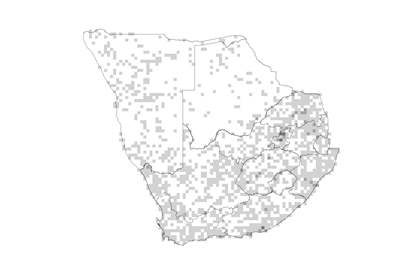 Species distribution and density. Darker squares represent higher density of members of this family. |
Introduction
Tomato family
The family is of major economic importance worldwide as a food source, including tomatoes, potatoes, aubergines, chillies and many others. In our region it is mostly known for exotic and weedy species as well as cultivated fruit and vegetables.
Distribution
The family is distributed all over the world, mainly in tropical and subtropical regions. It is widespread throughout southern Africa with higher concentrations on the Highveld.
Number of genera in the world
90
Number of species in the world
ca. 2 600
Number of genera in the Flora of southern Africa region
12
Number of species in the Flora of southern Africa region
102
Well-known southern African genera
: *Capsicum, *Cestrum, *Datura, Lycium, Nicotiana, *Physalis, Solanum.
Growth forms
Herbs, shrubs or small trees.
Habitats
Widespread in natural veld, often as weeds on disturbed soils.
Flagship species
Lycium cinereum (small honey-thorn; kleinblaarkriedoring [A]) is the most widespread species of the genus and can be found almost everywhere except in coastal Namaqualand, Kalahari and the eastern Lowveld. It is a stiffly-branched, very spiny shrub up to 2 m tall. Leaves are clustered on branches and spine-tipped side branches. Flowers are cream-coloured with purplish lobes. Fruits are fleshy, bright orange to red with a persistent calyx. Fruits are sought after by birds.
Significance of the family
Most of the economically important members of the family are exotic, naturalised or cultivated in southern Africa, e.g. Cape gooseberry (*Physalis peruviana) and aubergine (*Solanum melongena). Potato (*Solanum tuberosum) is one of the most versatile vegetables; leaves of black nightshade (*Solanum nigrum) are eaten as potherb and the fruit are eaten raw or made into jam; thornapple (*Datura stramonium) is used in traditional medicine to treat respiratory difficulties and to reduce pain; winter cherry (Withania somnifera) is used medicinally.
Diagnostic characters
Plants often have a strong scent when crushed. Leaves mostly alternate with flowers often opposite the leaves . Flowers regular; stamens open with apical pores � or longitudinal slits. Fruits fleshy berries or dry capsules ; ovaries 2-chambered , superior.
Did you know?
There are close to 4 000 different varieties of potato grown in the world, which makes it the fourth largest food crop.